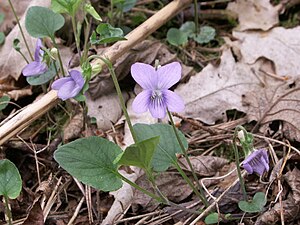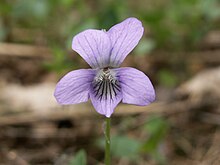Dog violets
| Dog violets | ||||||||||||
|---|---|---|---|---|---|---|---|---|---|---|---|---|

Dog violet ( Viola canina ) |
||||||||||||
| Systematics | ||||||||||||
|
||||||||||||
| Scientific name | ||||||||||||
| Viola canina | ||||||||||||
| L. |
The Heath Dog-violet ( Viola canina ), also Roßveilchen called, is a plant type from the family of the violet plants . The odorless dog violet is next to the fragrant violet the best known violet species.
description
The perennial herbaceous plant is between 5 and 20 cm high. The leaf blade of the summer leaves is ovate-heart-shaped and hairless at the base. The leaves do not form a basal rosette, but rather have long stems on the stem. Each petiole has a pair of stipules at the base, which are thinly toothed on the edge. The mostly light purple flowers are each at the tip of the stem. The sepals are 5 to 7 mm long, including their appendages. The spur of the crown is whitish, slightly curved and notched lengthways. The lower petal has violet veins on a white background. Otherwise the flower color is (light) blue-purple. Flowering time is from March to June.
The chromosome number for all three subspecies is 2n = 40.
Occurrence
As a location, this plant species prefers nutrient-poor, acidic, sandy loam soils and is often found on heaths, grasslands and in sparse forests or at the edges of forests. It is a federation character of the Violion caninae federation in Central Europe, but also occurs in societies of the Mesobromion or Molinion. The dog violet is common all over Europe and Western Asia.
Subspecies
- Common dog violet ( Viola canina subsp. Canina ): The length of the leaf blade is 1.2 to twice its width. The stipules of the central stem leaves are 1/6 to 1/3 as long as the corresponding petiole. The sepals are pointed and the petals are blue-violet. The spur is once or twice as long as the calyx appendages, mostly straight and yellowish green. In the Allgäu Alps, this subspecies rises in the Tyrolean part of the Nagelskopf near Hägerau up to an altitude of 1600 meters.
- Mountain dog violet ( Viola canina subsp. Montana (L.) Hartm. ): The 7 to 12 cm large mountain dog violet is a compact, permanent subspecies with a perennial rosette of narrow, heart-shaped, dark green leaves from which the elongated flower stems with strong blue flowers emerge in spring form. In contrast to the common dog violet, the leaf blade is about twice as long as it is wide. In addition, the stipules are longer (approx. 1/3 to 2/3 of the petioles), the petals pale blue to white and the spur whitish. This subspecies is native to mountain meadows all over Europe. It grows on humus rich, well drained soils in sunny locations. The flowering period is April to May.
- Schultz's dog violet ( Viola canina subsp. Schultzii (Bill.) Kirschl. ): Compared to the common dog violet, it has a longer, blunt-fronted leaf base. In addition, the sepals are pointed, the petals blue-violet and the spur is strongly curved upwards and greenish or yellowish in color. This subspecies, which occurs mainly in wet meadows, is extinct or has disappeared in Germany. Note from FloraWeb: According to Lippert opposite Korneck (mdl.), Only the southwestern German occurrences really concern Schultz's violets, while the Bavarian moor occurrences clearly differ morphologically from the individuals of the locus classicus and are possibly to be regarded as miserable forms of the real V. canina . In Germany, all previously known locations are considered to be extinct. Other regional flora can only record very old information (e.g. Styria before 1930, Alsace 1965, Romania 1955, Switzerland). A current find apparently only exists in Upper Savoy (cf. Charpin & Jordan 1992). The information on the existing situation results in an average frequency value of 1.25. So Schultz's violets must be viewed as a clan that is on the verge of extinction and deserves protection to the highest degree.
Sources and further information
- W. Rothmaler: Excursion flora from Germany, vascular plants: basic volume. Berlin 1999, ISBN 3-8274-0912-8 .
Individual evidence
- ↑ Oskar Sebald : Guide through nature. Wild plants of Central Europe. ADAC Verlag, Munich 1989, ISBN 3-87003-352-5 , p. 63.
- ↑ Gunter Steinbach (ed.): The plants of our home. Signpost through nature. ADAC-Verlag, Munich 1999, ISBN 3-87003-879-9 , page 90.
- ↑ a b Erich Oberdorfer : Plant-sociological excursion flora for Germany and neighboring areas . With the collaboration of Angelika Schwabe and Theo Müller. 8th, heavily revised and expanded edition. Eugen Ulmer, Stuttgart (Hohenheim) 2001, ISBN 3-8001-3131-5 , pp. 675 .
- ↑ Erhard Dörr, Wolfgang Lippert : Flora of the Allgäu and its surroundings. Volume 2, IHW, Eching 2004, ISBN 3-930167-61-1 , p. 236.
Web links
- Dog violets. In: FloraWeb.de.
- Profile and distribution map for Bavaria . In: Botanical Information Hub of Bavaria .
- Dog violets . In: BiolFlor, the database of biological-ecological characteristics of the flora of Germany.
- Viola canina s. l. auct. helv. In: Info Flora , the national data and information center for Swiss flora . Retrieved December 25, 2015.
- Area map Viola canina subsp. canina
- Area map Viola canina subsp. Montana
- Thomas Meyer: Data sheet with identification key and photos at Flora-de: Flora von Deutschland (old name of the website: Flowers in Swabia )
- Thomas Meyer: Data sheet with identification key and photos at Flora-de: Flora von Deutschland (old name of the website: Flowers in Swabia )
